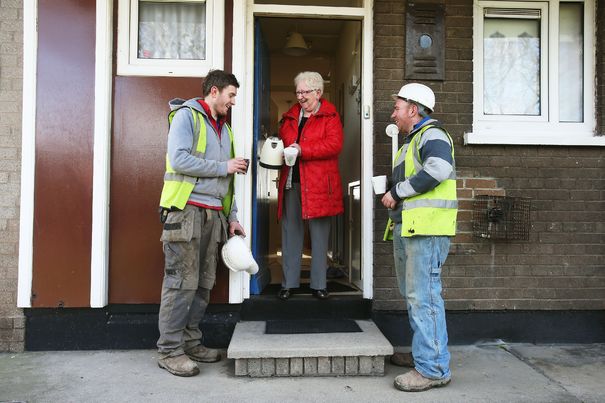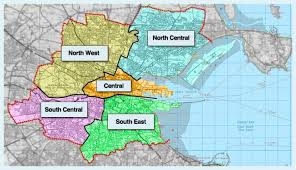Dublin 8’s Age Friendly City In Progress
Life becomes more challenging once we get older, we physically stiffen up and become a little less mobile than we were in youth. For example, an outing to the shops can become a burdensome and difficult excursion. The Dublin City Age Friendly Strategy 2014-2019 is an initiative that will help solve these type of problems and many others for an ever aging generation. Dublin is the first city in the world to adopt this city-wide age-friendly approach. Dublin 8 falls under the South Central Area, one of five Dublin City Council administration areas currently being surveyed for the changes yet to be made in the next five years.
Over 22% of the population of Dublin South Central are 55 year-olds and over. So far 18 volunteers who conducted ‘on-street’ conversations in 12 different locations to get an insight into 166 older people’s views on the environment (litter and street cleaning), safety and anti-social behaviour, the state of footpaths and road maintenance.
The general feeling was seniors felt positive about their neighbours, the public transport system and the sense of community in their areas. Over 200 people aged 55 and older attended three round table consultations in Ballyfermot, Crumlin and Kilmainham and a large service provider consultation also took place. All of the information gathered from these consultations is being processed and was presented to an interagency alliance.
Talking to some older citizens on St James’s Street I found out bus stops in the vicinity of the Lidl and the St Augustine and St John the Baptist Church are still not up to a standard that can accommodate older travellers. Bus stops 1999 and 1998 have no seats for people waiting on the bus and bus stop 1939 has no shelter or place to sit. Most of the stops on the other side of St James’s Street still sport the very narrow seats, but further down towards the Guinness Storehouse bus stops have been fitted with newer wider seats.
An elderly lady waiting at bus stop 1999 said: “Older people coming from the church (St John’s Lane Church) all come to this bus stop and there is no place to sit, it is a problem for older people. Seats at other bus stops are very narrow and uncomfortable to sit on, but it is better than nowhere to sit. Wider seats would be better.”
An elderly man at bus stop 1998 said: “There is nowhere for older people to sit here waiting on the bus. Busses can take 10 minutes to arrive and sometimes when a bus breaks down you could be waiting for 20 minutes. At anytime people could be waiting on three or more busses to arrive. This is a problem in Dublin, no one cares and they won’t spend the money on us, the older people.”
Gathering from the response of these older citizens it would appear that there are much room for improvement and that little changes to the infrastructure of the city, for example getting the shelters up to a standard that makes waiting on a bus easier, could make a lot of people instantly happier.
The most recent census done in 2011 estimated that Dublin City has a population of 527,612. The census also revealed that nearly 113,700 of these people were aged 55 or older; that accounts for 21.5% of the population. Nowadays, people live longer than in times past – this means that by the year 2041, 1.4 million people will be 65 years and over, nearly 22% of the total population.
Elderly people have to move around their cities to get things done or get to work (those who are still in employment as well) and therefore, needs better and more convenient ways of getting there by transport or moving about shops and staircases etc. These were only some of the problems we faced before Ireland launched the Dublin City Age Friendly Strategy nationally on the 10th September 2014. With a five year plan in mind it will aim to meet the needs of older people in counties, cities and towns across Ireland in order to make them as age friendly as possible.
Eight International and National Strategies and Frameworks have been drawn from to create the Dublin City Age Friendly Strategy for 2014-2019. These include: the Madrid International Plan of Action on Ageing (2002); World Health Organisation’s Global Age-friendly Cities: A Guide (2007); National Action Plan on Social Inclusion 2007- 2016; Programme for Government 2011-2016; Dublin City Development Plan 2011-2017; Putting People First: Action Programme for Effective Local Government (2012); National Positive Ageing Strategy (2013); Healthy Ireland (2013).
The World Health Organisation’s Global Age Friendly Cities and Communities’: A Guide 2007 states: “In practical terms an age-friendly city adapts its structures and services to be accessible to and inclusive of older people with varying needs and capacities.”
Getting to places with proper transport; getting off buses, trams and taxi’s safely; safe staircases and escalators or accessible lifts; easy accessible shops with wide aisles for wheelchair and bag-on-wheel basket users; seating and service in restaurants and coffee shops for older people – are only a few everyday examples of what is needed to make an older person’s life easier in a busy city, town or village.
There are nine main areas that will be paid attention to in the building of an Age Friendly Dublin: outdoor space and buildings; transport, home and community; information; safety; learn; develop and work; social, economic and political life; healthy and active living; and value and respect.
It is hoped that by 2019 all the objectives that has been set out in the Dublin City Age Friendly Strategy will have been met. This would mean an easier lifestyle for the 22% old people living in Dublin. The Central Statistics Office (CSO) classifies an old person as a person who is 65 years and older, whereas the WHO classifies a person older than 55 as an old person. It is said that in Ireland you are only considered old once you get your pension or you retire from work. According to one study by Martin, Poon and Johnson 1996, there are sub-categories that define how old an old person is. These are young-old, old-old and oldest-old, because old people themselves categorises themselves by relating their age to other older people.
“I want to thank everyone who has been and who continues to be involved in this important initiative, especially older people themselves. I strongly believe that if we can make Dublin a place that is truly friendly for older people then it will be a great place for everyone who lives or visits the city. I ask everyone to play their part in helping us to bring the vision and goals of the Strategy to life, and to make a full-hearted commitment to the values we have signed up to. And, may I remind you; with any luck a healthy old age is a future which awaits us all. Go maire tú gach lá de do shaol,” the previous Lord Mayor Christy Burke said.
To date 29 out of 31 Local Authorities have now formally adopted the Age Friendly Cities and Counties Programme.










